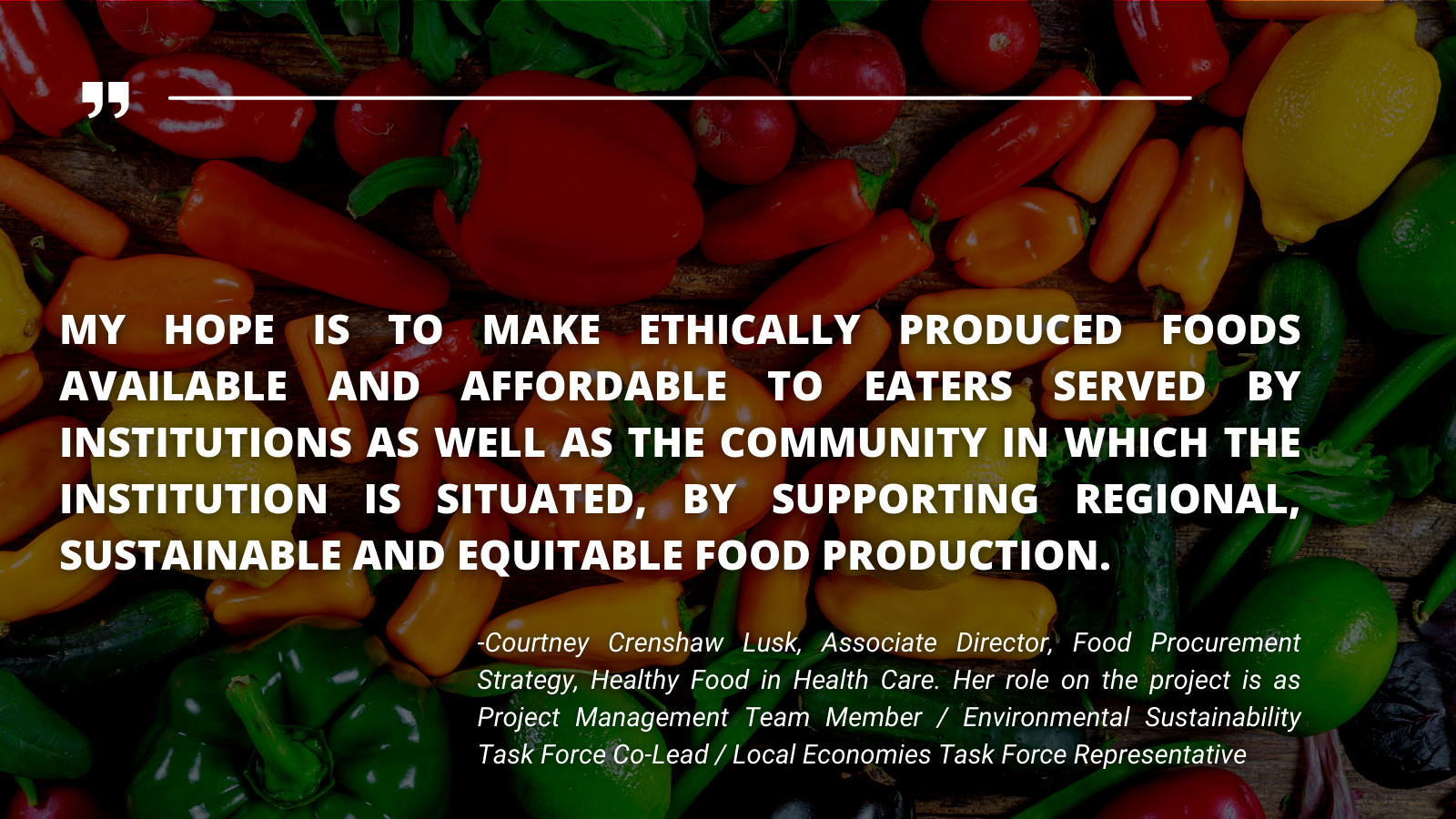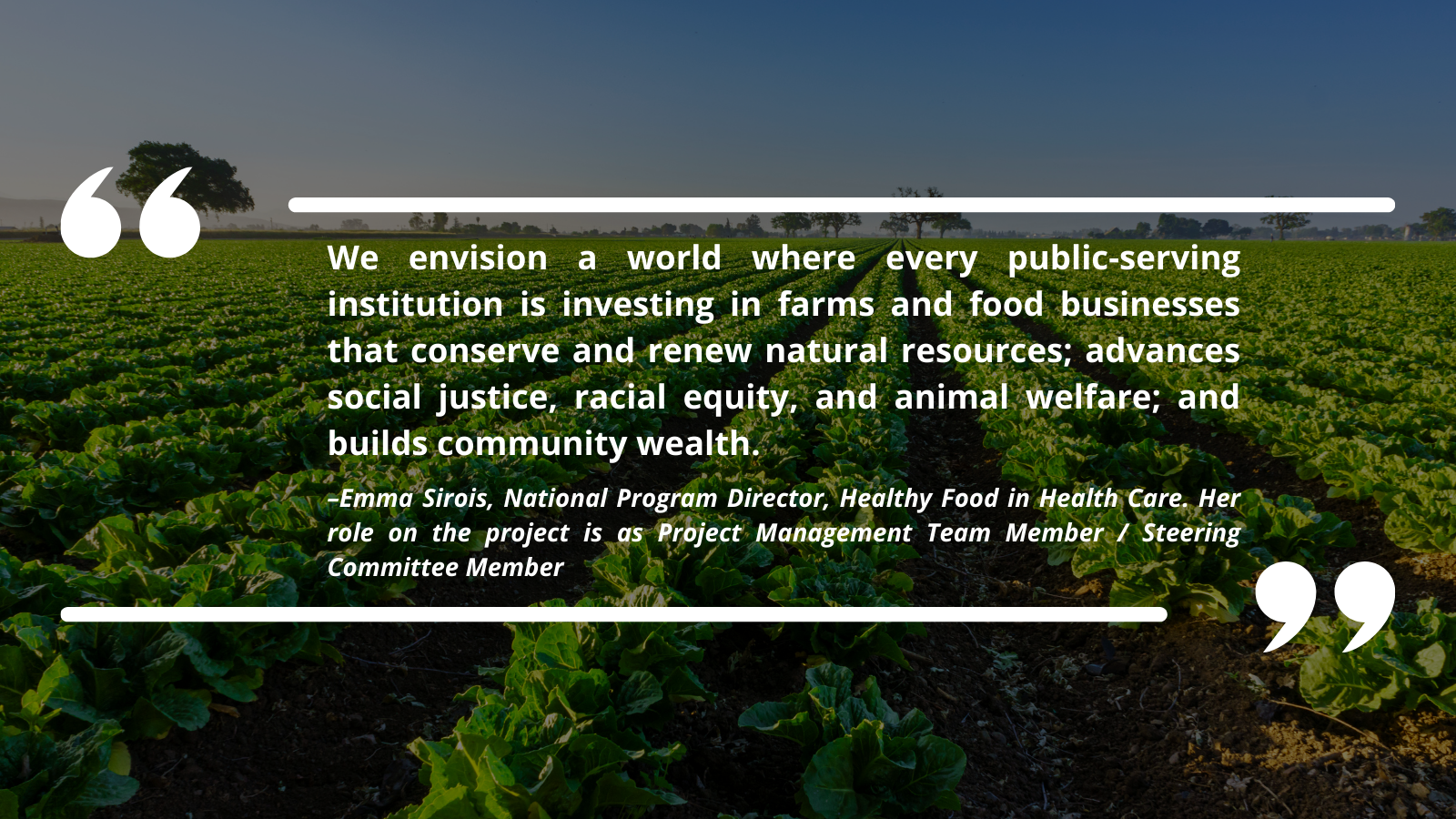Anchors in Action: Building a Future Towards the Food System We Envision
By Carmi Orenstein and Ted Schettler, SEHN
Imagine if we and our children could eat institutional meals—whether in schools, universities, or hospitals—that were nourishing as well as reflective of our values? Many of us have delighted in changes we’ve been fortunate to see on at least a small scale, such as on-site school gardens that involve the students and supply the cafeteria’s kitchen. But we also recognize that food system change is needed on a much larger scale in order to truly address problems ranging from poor nutrition, to food production, workplace health and safety, to impacts on land, water and climate. We have new data that shows just how profound these impacts are, and how expensive. Fortunately, there are exciting new developments that aim to harness the economic power of institutional food procurement, dramatically strengthening efforts to reverse the harms of the current global food system.
“The food system is the single largest economic sector causing the transgressing of planetary boundaries,” according to Swedish environmental scientist Johan Rockstrom, one of the co-chairs of the international “EAT-Lancet Commission.” In 2019 The EAT-Lancet Commission created the first assessment of the changes required of global food systems to promote human health without violating planetary boundaries—the biophysical processes of the Earth required for healthy humans beings and ecosystems. Four of the boundaries—climate thresholds, biosphere integrity, land systems, and biogeochemical cycles (phosphorus and nitrogen)—have already been breached. But in that first report (they are now working on a second, due out in 2024), the EAT-Lancet Commission determined that it is entirely possible for 10 billion people to eat diets that support their own health and are produced within sustainable limits. “Because food systems are a major driver of poor health and environmental degradation,” they wrote, “global efforts are urgently needed to collectively transform diets and food production.” They called for a “Great Food Transformation.”
Last year the Rockefeller Foundation recognized that collective recovery from the Covid-19 pandemic— which further exposed profound weaknesses in the U.S. food system—was a unique opportunity for its transformation. Their report, True Cost of Food: Measuring What Matters to Transform the U.S. Food System, described the “cross-cutting capabilities” needed to make these shifts. The report’s “true cost accounting” factors in impacts on health care, environment, and biodiversity, all of which take a disproportionate toll on communities of color in the United States. In food production work, there are profound societal costs stemming from unlivable wages, food insecurity, a lack of benefits including healthcare, and occupational injury and illness. The pandemic clearly revealed the fact that “workers bear the brunt of the unequal and unsustainable food system we live with today.” These injustices must be remedied.
The collective reimagining of the food system proposed in the Rockefeller report includes the concrete, logistical actions that influential organizations need to take: “We should direct the purchasing power of large institutions along a values-based (equitable, ethical, healthy, sustainable) supply chain by incentivizing, requiring, or otherwise enabling institutions’ food procurement to prioritize a diversity of producers and suppliers that embody these values.”
Who can do this work of “coordinated and concerted action” to jump-start the needed transformation of institutional purchasing (or procurement)? The work requires deep commitment and complex collaboration across sectors of government and civil society. Here in the United States, a partnership of three organizations has been immersed in harnessing this powerful lever for transformation of the current food system. Likely obscure to those not working behind the scenes at institutions such as schools, universities, and hospitals, procurement wields tremendous power in the food economy. The partner organizations, Real Food Generation, The Center for Good Food Purchasing, and Health Care Without Harm, themselves currently represent 7,800 elementary and secondary schools, 1,800 hospitals, 194 colleges and universities, and over 57 public institutions in 23 major cities. These institutions collectively represent food service budgets in the hundreds of millions of dollars. Combining that amount of purchasing power with ethics and values held in common by the partners—and the influence and reach of these “anchor institutions”—has the potential to transform the U.S. food landscape.
As anchor institutions, they are rooted in place, holding significant investments in real estate and social capital, are among the largest employers in their communities, and are often explicitly oriented toward supporting community health in alignment with their missions.
The “Anchors in Action” (AiA) alliance has now completed the work of developing a shared purchasing framework based on a unified set of core principles, value definitions, product and supplier criteria, and institutional strategies that can serve as a foundation for each organization’s respective food purchasing standards. This framework is also meant to:
…drive change by unifying demand within and across institutional networks for supply chains that benefit all people, especially underserved and marginalized communities. The framework is organized around five values: Local & Community Based Economies, Environmental Sustainability, Valued Workforce, Animal Welfare, and Community Health & Nutrition. These values are built upon the foundation of our core principles: Racial Equity, Climate Justice, and Food Sovereignty. We uphold each of these values equally, with the understanding that food systems transformation must be viewed holistically. We are explicitly uplifting the three core principles, and have engaged community leaders in each of these areas to be an integral part of this process.
Ted Schettler, Science Director at SEHN, periodically had an opportunity to weigh in on the extensive AiA process via his affiliation with Health Care Without Harm, drawing on his expertise in the social determinants of health, public and environmental health impacts of food systems, and work with countless organizations on transformation in support of health and environment. Schettler says he is,
… cautiously optimistic that the AiA criteria and standards will help to catalyze long-overdue systems-level changes throughout the food value chain. Where adopted, the standards will uniquely and simultaneously address many of the adverse impacts of the current dominant food-system on human health, ecosystem health, and climate stability. But implementation of the standards will not be easy. As noted in the Rockefeller report, many of the true costs of food are not reflected in their price at the point of purchase, and food budgets may need to be modified in institutions adopting the new AiA standards.
“While it’s true that increasing budgets is an important piece of this puzzle and that making changes to an institution’s food program to prioritize good food can increase the institution’s food spend,” says Courtney Crenshaw Lusk, the Associate Director of Food Procurement Strategy for Healthy Food in Health Care, with Health Care Without Harm, “the unique processes, geography, staff, goals, and relationships of the institutions can and should directly inform their cost management strategies.” She explains,
The new framework presents some key strategies for managing food costs (i.e buying seasonal produce and whole and unprocessed ingredients) and emphasizes a shift in priorities (i.e. incorporating scratch-cooking whenever possible and building relationships with local and regional vendors who are values-aligned with the institution) that better support values-based food purchasing. There are also non-cost strategies associated with achieving compliance in some of the value categories, such as outreach to suppliers with repeat and egregious labor violations. Therefore, there are lots of opportunities for hospital purchasers to address many of the adverse impacts of the current food system that Ted referenced above.
As the values and principles the partners articulate suggest, AiA’s intention for the transformation of our food system goes far beyond “health” and “sustainability” in the usual senses. The AiA framework’s definitions and strategies envision a food system that embraces participatory decision making, is fair and just to everyone along its supply chains, and supports the local economies in which institutions are situated.
Stakeholders were invited to engage in a creative public review process, ensuring that Project development integrated the critical perspectives of community members on the ground in organizations, institutions, and campuses. This vision for a restorative food system is not static and aims to provide ongoing opportunities for farmers, workers, and eaters to participate in decision-making with regard to the ways food is produced, processed, distributed, marketed, consumed, and disposed.
AiA aims for a fall 2022 release of the aligned standards along with implementation strategies from participating organizations. Already, excitement is building for the Project’s potential for dramatic impact as links increase between institutional markets and values-based food producers, and taxpayer dollars that run through public institutions begin to pay for foods that nourish individuals and communities. Imagine knowing that meals eaten in schools, hospitals, and universities no longer potentially conflict with values of racial justice, worker rights, and climate action!
It is a direction the country cannot afford to not go. As the Rockefeller Foundation report warns, “If left unaddressed, the true cost of food will continue to rise and negatively contribute to climate change, the prevalence of diet-related diseases, and growing inequity.” The AiA project has already made large strides toward alleviating that risk. With so much of the work done for them, organizations should jump at the opportunity to participate in values-based food procurement. All of us—students, parents, potential hospital patients, workers in the public and private sectors—should demand it.




